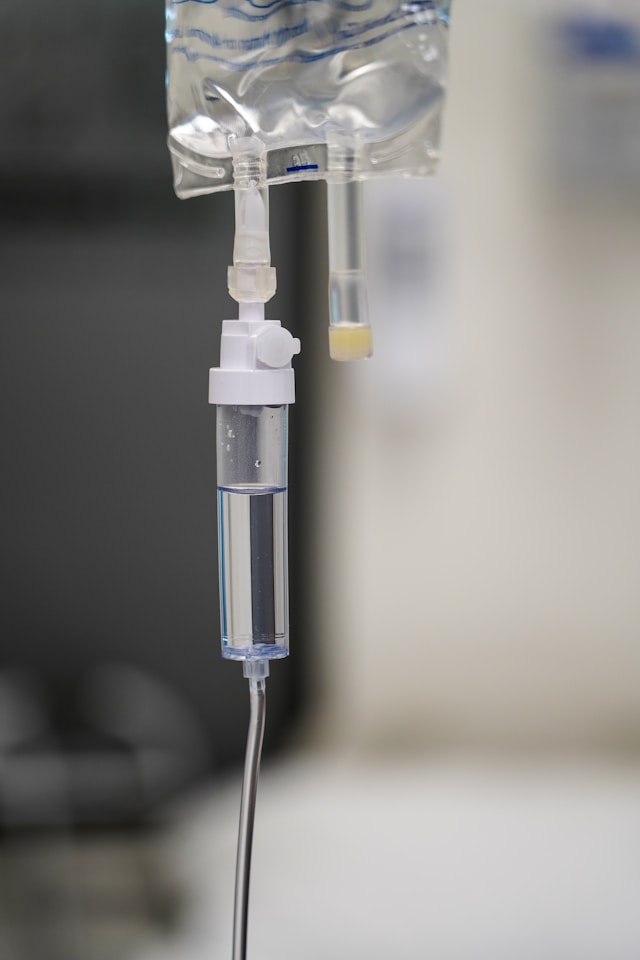
Infusion Therapy for Chronic Migraines


Dr. Chen is a board-certified immunologist with over 15 years of experience treating autoimmune and immunodeficiency disorders. She specializes in IVIG therapy and has published extensively on immune system treatments.
Medical Disclaimer
Chronic migraines—defined as 15 or more headache days per month with at least 8 being migraine days—can be debilitating, affecting your ability to work, maintain relationships, and enjoy life. When oral preventive medications don't provide adequate relief, infusion therapy with CGRP (calcitonin gene-related peptide) inhibitors offers a powerful new treatment option that can significantly reduce migraine frequency and severity. Understanding how infusion therapy works for chronic migraines helps you explore this innovative treatment approach.
Key Highlights
- Vyepti (eptinezumab) is the only CGRP inhibitor given by infusion for migraine prevention, administered every 3 months in a quick 30-minute appointment.
- Many chronic migraine patients experience 50% or greater reduction in monthly migraine days, with some becoming nearly migraine-free on CGRP therapy.
- Infusion therapy for migraines offers rapid onset (often within 24 hours) and convenient quarterly dosing, with fewer side effects than many traditional preventive medications.
Understanding Chronic Migraines
Migraines are neurological disorders causing recurrent attacks of moderate to severe throbbing head pain, typically on one side of the head, accompanied by nausea, vomiting, and sensitivity to light and sound. Some people experience aura—visual disturbances, tingling, or other neurological symptoms—before headache onset.
Chronic migraine is distinguished from episodic migraine by frequency: experiencing headaches 15 or more days per month, with at least 8 meeting migraine criteria or responding to migraine-specific treatment. Chronic migraine is often associated with medication overuse, though many patients develop it without overusing acute treatments.
The impact of chronic migraine is profound—frequent debilitating headaches interfere with work, family responsibilities, social activities, and quality of life. Depression, anxiety, and sleep disorders commonly co-occur. According to the American Migraine Foundation, approximately 4 million Americans have chronic migraine.
Without effective treatment, chronic migraine significantly impairs function and wellbeing. Preventive treatment reducing attack frequency and severity is essential for chronic migraine management.
Why Infusion Therapy for Chronic Migraines
CGRP inhibitor infusions have transformed migraine prevention:
Targeting Migraine Mechanism: CGRP inhibitors block calcitonin gene-related peptide, a molecule that plays a key role in migraine attacks. This represents the first preventive therapy designed specifically for migraine rather than repurposed medications developed for other conditions.
High Efficacy: Clinical trials show CGRP inhibitors reduce monthly migraine days by 50% or more in about 60% of chronic migraine patients, with 20-30% experiencing 75% or greater reduction.
Rapid Onset: Unlike traditional preventives that take 4-8 weeks to work, Vyepti often shows benefit within 24 hours to one week.
Convenient Dosing: Quarterly infusions are more convenient than daily oral preventives or monthly self-injections (the other CGRP inhibitor delivery method).
Favorable Side Effect Profile: CGRP inhibitors typically cause fewer side effects than traditional preventives like beta-blockers, antidepressants, or anti-seizure medications.
Works After Other Preventives Fail: CGRP inhibitors help many patients who haven't responded to multiple prior preventive trials.
The American Headache Society recognizes CGRP inhibitors as important advances in migraine treatment.
Vyepti: The CGRP Infusion Option
Vyepti (Eptinezumab) is the only CGRP inhibitor given by IV infusion. It's a monoclonal antibody that binds to and blocks CGRP, preventing it from triggering migraine pathways.
Dosing: 100 mg or 300 mg infused over 30 minutes every 3 months. Most patients start with 100 mg; the 300 mg dose may be used for patients needing stronger prevention.
Administration: Given at infusion centers, neurology clinics, or headache specialty centers. The quick 30-minute infusion time makes it one of the fastest infusion therapies.
Who It's For: FDA-approved for migraine prevention in adults, including both episodic and chronic migraine. Particularly beneficial for patients who haven't responded to 2-3 prior preventive medications or who struggle with daily oral medication adherence.
According to the Mayo Clinic, Vyepti's rapid onset and infrequent dosing make it appealing for many chronic migraine patients.
What to Expect from Vyepti Infusion Therapy
Starting Treatment: Your first Vyepti infusion involves standard medical history review, vital sign checks, and IV placement. The infusion itself takes only 30 minutes—much quicker than most biologic infusions. You'll remain for brief post-infusion monitoring (typically 15-30 minutes).
Immediate Response: Many patients notice migraine reduction within the first week, with some experiencing benefit within 24 hours of their first infusion. This rapid onset distinguishes Vyepti from traditional preventives.
Building Efficacy: While some patients respond dramatically to the first infusion, full benefit often develops over 2-3 quarterly infusions as CGRP blockade accumulates.
Quarterly Schedule: Returning every 3 months for 30-minute infusions is manageable for most patients and far more convenient than daily pills or monthly injections.
Continuing Acute Treatments: Vyepti is preventive therapy—you'll still use acute migraine medications (triptans, NSAIDs, etc.) for breakthrough migraines, though you'll likely need them far less frequently.
Other Preventives: Some patients continue other preventive medications alongside Vyepti, though many can discontinue or reduce other preventives as CGRP therapy proves effective.
Benefits of Vyepti for Chronic Migraines
Patients responding well to Vyepti often experience:
Significant Migraine Reduction: Average reduction of 4-5 monthly migraine days in chronic migraine patients, with many experiencing 50% or greater reduction.
Decreased Migraine Severity: When migraines do occur, they're often less severe and respond better to acute treatments.
Reduced Acute Medication Use: Fewer migraines mean less reliance on triptans, NSAIDs, or other acute medications, reducing medication overuse risk and expense.
Improved Function: Better ability to work, maintain social commitments, exercise, and participate in daily activities without constant migraine interference.
Better Quality of Life: Significant improvement in overall wellbeing, mood, sleep, and life satisfaction.
Rapid Relief: Unlike traditional preventives requiring weeks to work, many patients notice improvement within days.
Minimal Side Effects: Most patients tolerate Vyepti very well with few or no bothersome side effects.
Convenience: Quarterly 30-minute appointments are far easier than daily pills, weekly injections, or monthly treatments.
Reduced Migraine-Related Disability: Decreased absenteeism from work, fewer emergency room visits, and less impact on family and social life.
The National Institute of Neurological Disorders and Stroke emphasizes that effective preventive treatment transforms quality of life for chronic migraine patients.
Potential Side Effects
Vyepti has a favorable safety profile, but potential side effects include:
Nasopharyngitis: Cold-like symptoms or nasal congestion, the most common side effect, occurring in about 15% of patients.
Infusion Site Reactions: Mild irritation at the IV site is possible but usually minor.
Hypersensitivity Reactions: Rare allergic reactions can occur. Symptoms include rash, flushing, shortness of breath, or facial swelling. Infusion centers are prepared to manage these if they occur.
Constipation: Some patients report mild constipation, though this is uncommon and usually manageable.
Fatigue: Occasional reports of tiredness, though many patients actually have more energy with fewer migraines.
Serious side effects are rare with Vyepti. Long-term safety data continues to accumulate, but CGRP inhibitors as a class have shown good safety profiles in years of use.
Vyepti vs. Other CGRP Inhibitors
Four CGRP inhibitors are available for migraine prevention:
Injectable CGRPs (Aimovig, Ajovy, Emgality): Self-administered monthly or quarterly injections at home. Effective and convenient but require self-injection.
Vyepti (IV infusion): 30-minute quarterly infusions at a medical facility. Offers fastest onset and avoids self-injection but requires clinic visits.
All four are similarly effective. Choice depends on personal preference—some patients prefer avoiding self-injections and appreciate rapid Vyepti onset, while others prefer home-based injectable convenience. Some insurance plans prefer one over others. Trying one CGRP inhibitor and switching to another if response is inadequate is reasonable.
Living with Chronic Migraines on Vyepti
Migraine Tracking: Continue tracking migraine frequency, severity, and acute medication use to assess treatment effectiveness and guide dose adjustments if needed.
Trigger Management: While Vyepti reduces migraine susceptibility, identifying and managing triggers (sleep regularity, stress, certain foods, hormonal changes) provides additional benefit.
Comprehensive Approach: Combine Vyepti with lifestyle measures—regular sleep schedule, stress management, regular exercise, adequate hydration, avoiding known triggers.
Acute Treatment Strategy: Work with your neurologist to optimize acute migraine treatment for breakthrough attacks. Effective acute treatment plus strong prevention provides best overall migraine control.
Treatment Adherence: Keep quarterly infusion appointments consistently. Missing doses may lead to increased migraine frequency.
Realistic Expectations: While many patients experience dramatic improvement, few become completely migraine-free. A 50% reduction in migraine days represents excellent response and meaningful quality of life improvement.
Cost and Insurance Considerations
CGRP inhibitors including Vyepti are expensive medications:
Insurance Coverage: Most commercial insurance plans cover CGRP inhibitors for chronic migraine with prior authorization. Many require trying 2-3 traditional preventives first (step therapy), though neurologists can often appeal this requirement if clinically inappropriate.
Medicare Coverage: Medicare Part B covers Vyepti infusions, though Part D covers injectable CGRPs. Coverage specifics vary by plan.
Copay Assistance: Vyepti's manufacturer offers copay cards that can reduce out-of-pocket costs to $0 per infusion for eligible commercially insured patients.
Patient Assistance: For uninsured or underinsured patients, manufacturer patient assistance programs may provide Vyepti at no cost for those meeting income criteria.
Frequently Asked Questions
How effective is Vyepti for chronic migraines?
Vyepti is highly effective for chronic migraine prevention. Clinical trials showed that about 60% of chronic migraine patients experience 50% or greater reduction in monthly migraine days, with 20-30% achieving 75% or greater reduction. The average reduction is 4-5 fewer migraine days per month. Some patients become nearly migraine-free, while others have more modest improvement. Response is individual, but most chronic migraine patients experience meaningful benefit.
How quickly does Vyepti start working?
Vyepti has the fastest onset of any migraine preventive medication. Many patients notice reduction in migraines within 24 hours to one week after their first infusion. Clinical trials showed significant migraine reduction on day one after infusion. This rapid onset is a major advantage over traditional preventives that take 4-8 weeks to work. However, full benefit may continue building over 2-3 quarterly infusions.
How long does Vyepti infusion take?
The Vyepti infusion itself takes only 30 minutes, making it one of the quickest infusion therapies available. Total appointment time including check-in, vital signs, IV placement, the infusion, and brief post-infusion monitoring is typically 1-1.5 hours. This is significantly shorter than most other biologic infusions, making quarterly appointments very manageable even for busy schedules.
Can you use Vyepti with other migraine medications?
Yes, Vyepti is preventive therapy and you'll continue using acute migraine treatments (triptans, NSAIDs, gepants, etc.) for breakthrough migraines. You can also combine Vyepti with other preventive medications if needed, though many patients can reduce or discontinue other preventives once Vyepti proves effective. Botox and Vyepti can be used together for very refractory chronic migraine. Always discuss your complete medication regimen with your neurologist.
What if Vyepti doesn't work for my migraines?
If Vyepti doesn't provide adequate benefit after 2-3 quarterly infusions, several options exist. You might try a different CGRP inhibitor (switching from Vyepti to injectable CGRPs like Aimovig, Ajovy, or Emgality, or vice versa, can be effective as individual response varies). Other preventive options include Botox injections for chronic migraine, traditional preventives (beta-blockers, antidepressants, anti-seizure medications), or gepants (newer oral preventives). Finding effective migraine prevention sometimes requires trying multiple approaches.
Hope for Better Migraine Control
If you've been prescribed Vyepti for chronic migraines, it represents access to one of the most innovative and effective migraine preventive treatments available. While chronic migraine is a challenging condition, modern CGRP inhibitor therapy has helped countless patients regain control of their lives.
Many chronic migraine patients on Vyepti experience dramatic reduction in migraine frequency and severity, allowing them to return to work, enjoy social activities, and live without constant fear of the next debilitating headache.
Ready to explore Vyepti infusion therapy for your chronic migraines? Find infusion centers offering migraine treatment near you to discuss whether CGRP inhibitor therapy might transform your migraine management.
Medical Disclaimer: This content is for educational purposes only and is not a substitute for professional medical advice, diagnosis, or treatment. Always consult your healthcare provider with questions about your medical condition or treatment options.
Article Statistics


Table of Contents
Article Statistics










